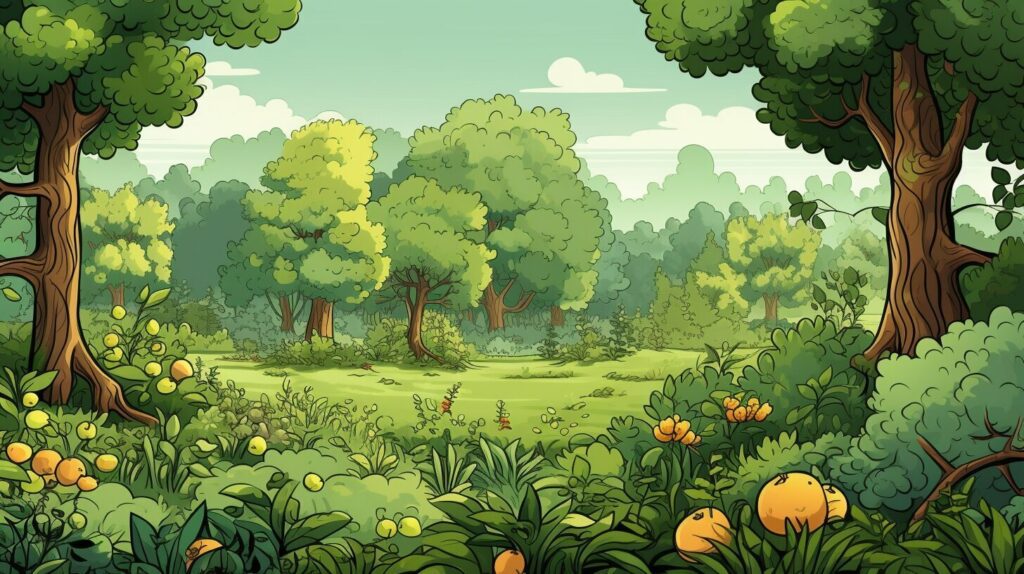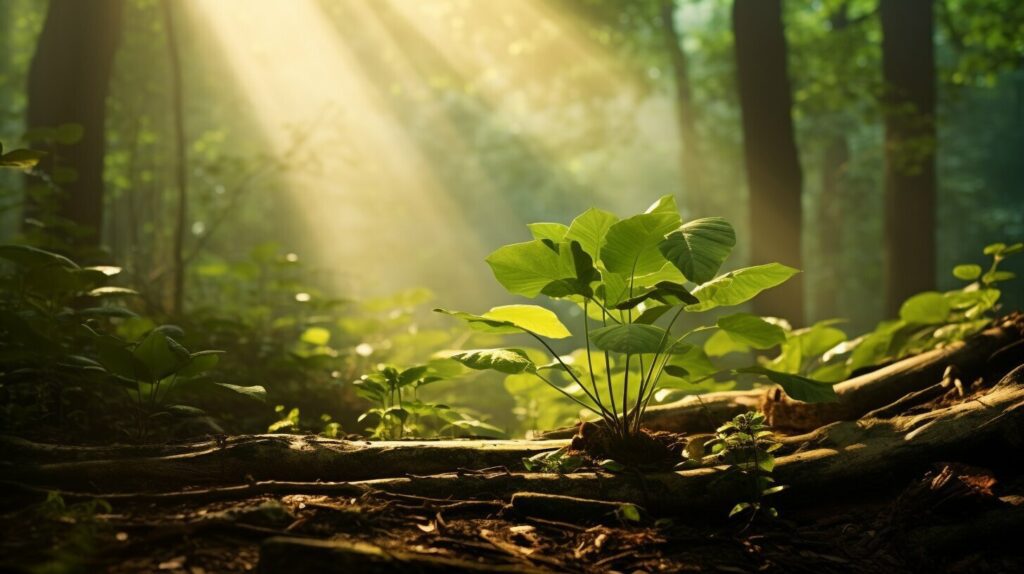Greetings, dear reader! Today, I will be exploring the fascinating world of autotrophism in plants. Have you ever wondered how plants obtain their energy and sustain themselves? Well, you’re in for a treat! In this article, we will answer the question: Are plants autotrophs? But before we delve into this topic, let me explain what autotrophism means.
Key Takeaways:
- Autotrophism is the ability of an organism to produce its own food.
- Plants are one of the most well-known examples of autotrophic organisms.
- The process of photosynthesis enables plants to convert light energy into chemical energy and synthesize organic compounds.
- Plants have evolved various adaptations for autotrophism, including specialized structures and physiological mechanisms.
- Autotrophic plants serve as the primary producers, providing food and energy for all other organisms in the ecosystem.
Now that we have a basic understanding of autotrophism let’s explore the concept in more detail and uncover the truth about plants as autotrophs.
Understanding Autotrophism in Plants
Autotrophism refers to the ability of an organism to produce its own food using basic raw materials like carbon dioxide, water, and sunlight. In the context of plants, autotrophism is the fundamental process by which plants sustain themselves.
Plants are unique in their autotrophic capabilities, producing their own energy through a process called photosynthesis. This process involves the absorption of light energy by specialized structures called chloroplasts, which are found in plant cells. Chlorophyll, a green pigment found in chloroplasts, plays a crucial role in photosynthesis by absorbing light energy.

Through photosynthesis, plants convert the absorbed light energy into chemical energy, which they use to create organic compounds, such as sugars and starches. This is the primary way in which autotrophic organisms in plants produce their own food.
Autotrophism in plants is a remarkable feature that allows them to be self-sufficient and independent of external food sources. The process of photosynthesis is fundamental to this self-nourishing nature of plants, and it is what sets plants apart from other organisms in the ecosystem.
The Process of Photosynthesis
Photosynthesis is a fundamental process through which plants convert light energy into chemical energy that they can use to synthesize organic compounds. It occurs in the chloroplasts, specialized structures found in plant cells, particularly in leaves. The process is divided into two stages:
- Light-dependent reactions: This stage involves the capture of light energy by pigments called chlorophyll. The light energy is used to produce energy-rich molecules called ATP and NADPH.
- Light-independent reactions: This stage involves the conversion of carbon dioxide and water, with the help of ATP and NADPH, into glucose. This glucose is then used by the plant as a source of energy for growth and reproduction.
The process of photosynthesis is essential for plant energy production and conversion, as well as for the production of oxygen, which is released into the atmosphere as a byproduct. Without photosynthesis, life as we know it would not be possible on Earth.

As autotrophic organisms, plants have developed several unique adaptations that enable them to sustain themselves without relying on external sources of energy. These adaptations range from specialized structures that facilitate the process of photosynthesis to unique physiological mechanisms that enable them to conserve water and fend off predators.
One of the most important adaptations for autotrophism in plants is the presence of chloroplasts. These specialized organelles contain chlorophyll, the pigment that absorbs light energy necessary for photosynthesis. The shape and arrangement of chloroplasts in plant cells facilitate the efficient capture of light, which is essential for energy production.

In addition to chloroplasts, plants have evolved several other adaptations that enable them to thrive in their environments. For example, many plants have developed specialized structures like leaves and stems that facilitate the absorption of water and nutrients from the soil. Some plants have also adapted to arid environments by developing mechanisms like crassulacean acid metabolism, which enables them to conserve water.
Plants have also developed strategies to defend themselves against predators. For example, some plants produce chemicals that are toxic to herbivores, while others have developed thorns and spines as physical deterrents. These adaptations enable plants to protect themselves while still carrying out the essential process of autotrophism.
Overall, the adaptations developed by plants for autotrophism are remarkable and diverse. These adaptations have enabled plants to thrive in a wide range of environments and contribute to the balance of life on Earth through the production of food and energy.
Importance of Autotrophic Plants
Autotrophism in plants is a crucial process that allows them to produce their own food and energy. As self-nourishing organisms, plants are the foundation of the food chain, providing sustenance to all other living organisms.
Without autotrophic plants, the entire ecosystem would collapse as there would be no primary producers to support the food chain. In addition, autotrophic plants play a vital role in maintaining the balance of the Earth’s atmosphere by absorbing carbon dioxide and releasing oxygen through photosynthesis.

Furthermore, autotrophic plants contribute to the overall health of the planet by stabilizing soil, preventing erosion, and providing habitats for various wildlife species. They also play a significant role in maintaining the Earth’s water cycle by regulating water vapor in the atmosphere and influencing precipitation patterns.
In conclusion, the importance of autotrophic plants cannot be overstated. They are essential for the survival of all living organisms on Earth and play a vital role in maintaining the planet’s overall health and balance.
Examples of Autotrophic Plants
Autotrophic plants come in all shapes and sizes. From towering trees to delicate flowers, the plant kingdom is incredibly diverse in its autotrophic capabilities. Let’s take a closer look at some notable examples:
| Plant | Unique Features |
|---|---|
| Bromeliads | These plants have specialized structures called “tank bromeliads” that collect water and nutrients, allowing them to thrive in nutrient-poor environments. |
| Succulents | These plants have thick, fleshy leaves that store water, allowing them to survive in arid environments with little rainfall. |
| Cacti | With their unique spines and ability to store water in their stem tissue, these plants are well-equipped to thrive in harsh desert climates. |
In addition to these examples, there are countless other autotrophic plants with fascinating adaptations and unique features. Each plant has its own way of obtaining and utilizing energy, making the plant kingdom a rich and complex area of study.

Plants are the quintessential autotrophs, but they are not the only ones. Autotrophism is prevalent in the plant kingdom, and includes various organisms like algae and mosses. Algae are found in both aquatic and terrestrial environments, and are important contributors to the ecosystem. They are photosynthetic like plants, but vary in size and complexity. Mosses, on the other hand, are small, nonvascular plants that grow in damp environments. They have unique adaptations for surviving in waterlogged conditions, and are important members of the ecosystem in their own right.
Autotrophism is a defining characteristic of the plant kingdom. It enables plants and other autotrophic organisms to produce their own food and energy, without having to rely on external sources. This self-sustaining capability is a fundamental component of the balance of life on Earth.

“The plant kingdom is incredibly diverse in its autotrophic capabilities.”
The importance of autotrophism in the plant kingdom cannot be overstated. Plants serve as the primary producers, providing food and energy for all other organisms. They play a vital role in maintaining the balance of the ecosystem, and are essential for the survival of all life on Earth.
The prevalence of autotrophism in the plant kingdom is a testament to the remarkable adaptability and ingenuity of nature. By exploring the diverse range of autotrophic organisms in plants, we can gain a deeper understanding of the complexity and beauty of the natural world.
Conclusion
In conclusion, I hope this article has shed light on the fascinating world of autotrophism in plants. We have explored how plant autotrophs produce their own food through the process of photosynthesis, and the unique adaptations they have developed for self-sustenance. The importance of autotrophic plants cannot be overstated as they serve as the foundation of the ecosystem, providing food and energy for all other organisms.
Plant Autotrophs: A Defining Characteristic
Autotrophism is a defining characteristic of plants and is what sets them apart from other organisms. It is through their ability to produce their own food that plants can grow, reproduce, and thrive. As we have seen, autotrophic organisms in plants have developed remarkable adaptations to ensure their self-nourishment, such as specialized structures like leaves and chloroplasts.
The Wonders of Autotrophism in Plants
The wonders of autotrophism in plants are truly remarkable and continue to fascinate scientists and nature enthusiasts alike. From towering trees to delicate flowers, plant autotrophs are incredibly diverse in their adaptations and capabilities. By understanding the prevalence and importance of autotrophism in the plant world, we can appreciate the incredible complexity and beauty of the natural world.
Exploring Autotrophic Organisms in Plants
Autotrophic organisms in plants are not limited to just trees and flowers. Algae, mosses, and other plant-like organisms also possess the ability to produce their own food through photosynthesis. By exploring the diverse nature of autotrophism in the plant kingdom, we can gain a deeper appreciation for the incredible complexity and balance of the natural world.
Overall, autotrophism in plants plays a vital role in the balance of life on Earth. Through my exploration of plant autotrophs, I have gained a deeper understanding and appreciation for the wonders of nature and the intricate mechanisms that sustain life on our planet.
FAQ
Q: Are plants autotrophs?
A: Yes, plants are autotrophs. Autotrophs are organisms that can produce their own food using energy from the environment, and plants achieve this through the process of photosynthesis.
Q: What is autotrophism in plants?
A: Autotrophism in plants refers to their ability to produce their own food. Through the process of photosynthesis, plants convert light energy into chemical energy, which they use to synthesize organic compounds, such as glucose.
Q: How do plants carry out photosynthesis?
A: Photosynthesis in plants involves the absorption of sunlight by chlorophyll in the chloroplasts. The light energy is then converted into chemical energy, which is used to convert carbon dioxide and water into glucose and oxygen.
Q: What adaptations do plants have for autotrophism?
A: Plants have various adaptations for autotrophism. Some examples include the presence of specialized structures like leaves, which maximize sunlight absorption, and chloroplasts, which contain chlorophyll for photosynthesis. Plants also have root systems to absorb water and nutrients from the soil.
Q: Why are autotrophic plants important?
A: Autotrophic plants are crucial for the ecosystem. They are the primary producers, converting light energy into food for other organisms. Without autotrophs, the energy flow in the food chain would be disrupted, impacting the survival of all other organisms.
Q: Can you provide examples of autotrophic plants?
A: Sure! Some examples of autotrophic plants include trees like oak and maple, flowering plants like roses and sunflowers, and aquatic plants like algae and seaweed.
Q: Are there different types of autotrophism in the plant kingdom?
A: Yes, within the plant kingdom, there are different types of autotrophic organisms. Apart from the commonly known land plants, there are also autotrophic organisms like algae and mosses that play an essential role in various ecosystems.





Pingback: Unlocking the Secret: How Plants Get Energy Explained